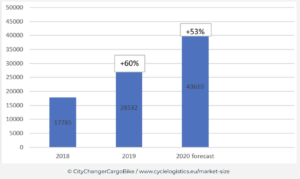The EU-funded CityChangerCargoBike project released key results of the first European Cargo Bike Industry Survey. These results are based on anonymized sales data provided by 38 cargo bike brands. After selling 17,800 cargo bikes in 2018 and 28,500 in 2019 the 38 survey participants expect to sell 43,600 cargo bikes across Europe in 2020.
While the sample of cargo bike brands cannot account for the total size of the European cargo bike market, it clearly indicates its trends growth. In 2019, sales of survey participants grew by around 60 percent. And despite the timing of the survey during the Coronavirus lockdown earlier this year, they expect an ongoing rapid increase of 53 percent for 2020.
Seven of the 38 brands are newcomers with no sales in 2018. While in 2018 none of the 38 surveyed brands sold more than 5,000 cargo bikes, three of them expect to do so in 2020. This shows the diversity and dynamism of the cargo bike industry with many young and still small brands and an increasing number of bigger players.
A study by CityChangerCargoBike project leader FGM-AMOR in 2013 showed a huge potential for cargo bikes and was quoted by the EU transport ministers‘ 2015 declaration on cycling: “more than half of all motorized cargo trips in EU cities could be shifted to bicycles”.
Different cargo bike types
The survey also asked each brand for the sales share of different cargo bike types and for their main national markets in Europe. Results:
- Sales of cargo bikes for private and for commercial use are growing equally fast. Their market shares remain almost equal.
- The majority of cargo bikes are sold with electric assist and their share of the market is growing. The share of cargo bikes without electric assist decreased from around 31 percent in 2018 to around 25 percent in 2019.
- Sales of three-wheeler cargo bikes are growing a little faster than two-wheelers. Their share is almost equal in expected sales for 2020. Four-wheeled cargo bikes don’t yet play a significant role.
- Germany is the most important national market in Europe for 16 of the 38 survey participants. Denmark (with a population 14 times smaller) was selected four times, UK, and the Netherlands three times. But the European cargo bike market is not limited to only a few top markets; 17 countries are among the top three markets of at least one of the survey participants.
High potential
Kevin Mayne, CEO Cycling Industries Europe, and partner of the CityChangerCargoBike project commented: “We have identified for some time that the cargo and delivery bike market has a really high potential for the cycling industries of Europe. This survey makes me very confident that we are on the right track, with the sector doing well and a diverse range of vehicles increasingly meeting all market needs across Europe”.
Berlin-based cargo bike expert Arne Behrensen, the editor of cargobike.jetzt and coordinator of the survey, added: “50 – 60 percent annual market growth is in line with observations of CityChangerCargoBike partners who promote cargo bike use across Europe. But in many regions, the cargo bike revolution is still at a very early stage. Decarbonizing transport, improving air quality, and regaining public street space needs more political support for sustainable vehicles like cargo bikes”.
Source: Cargobike.jetzt

